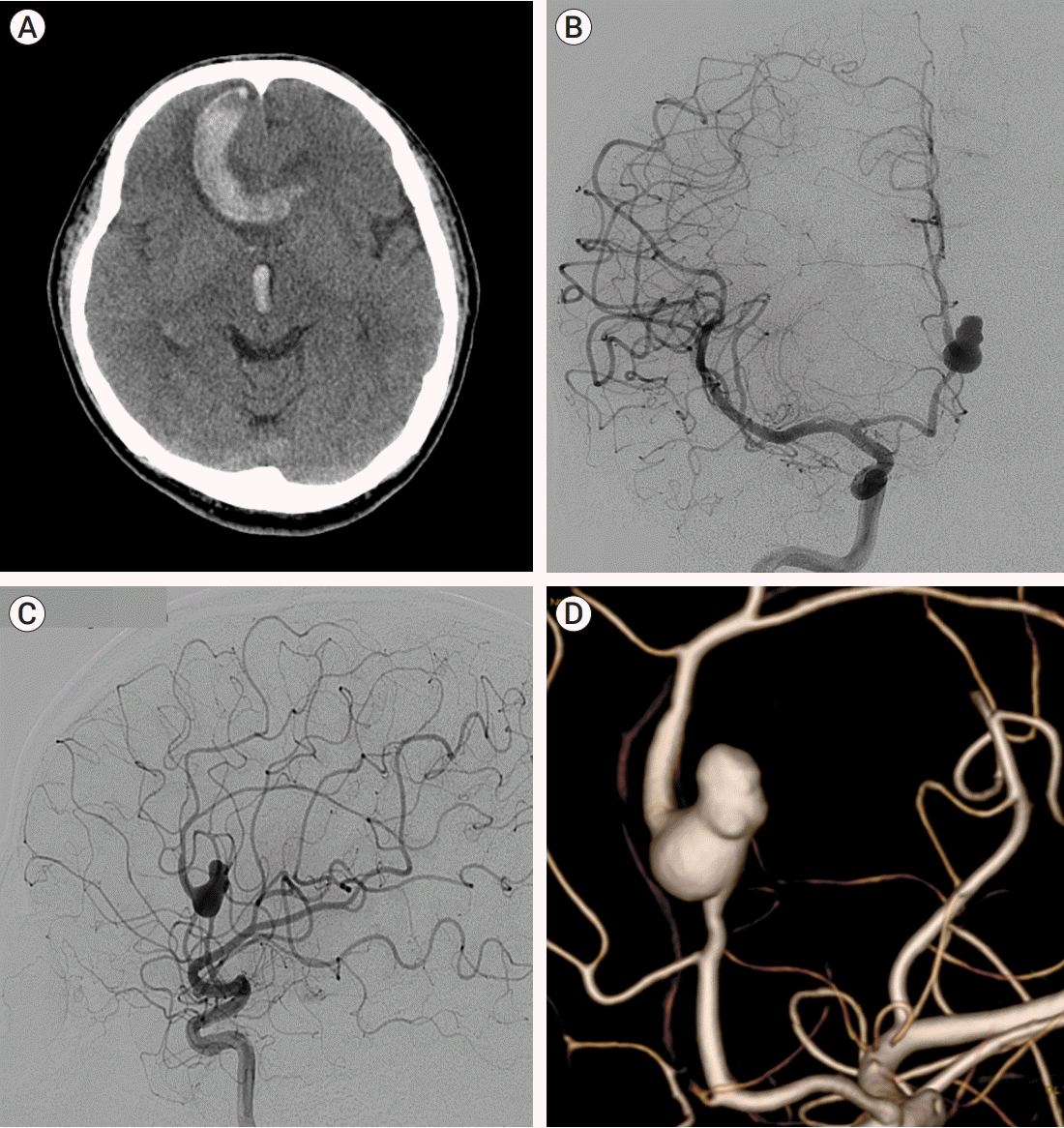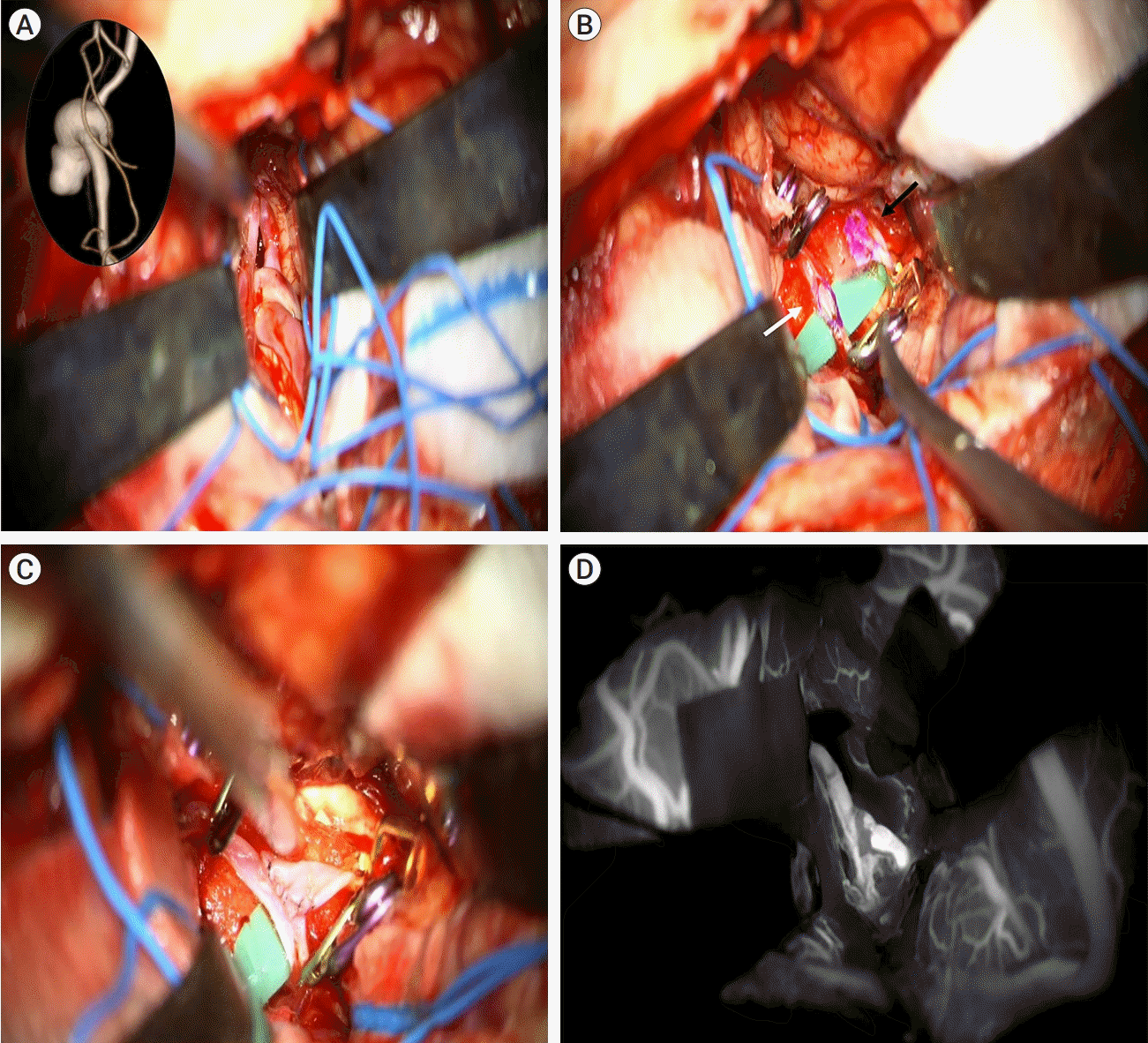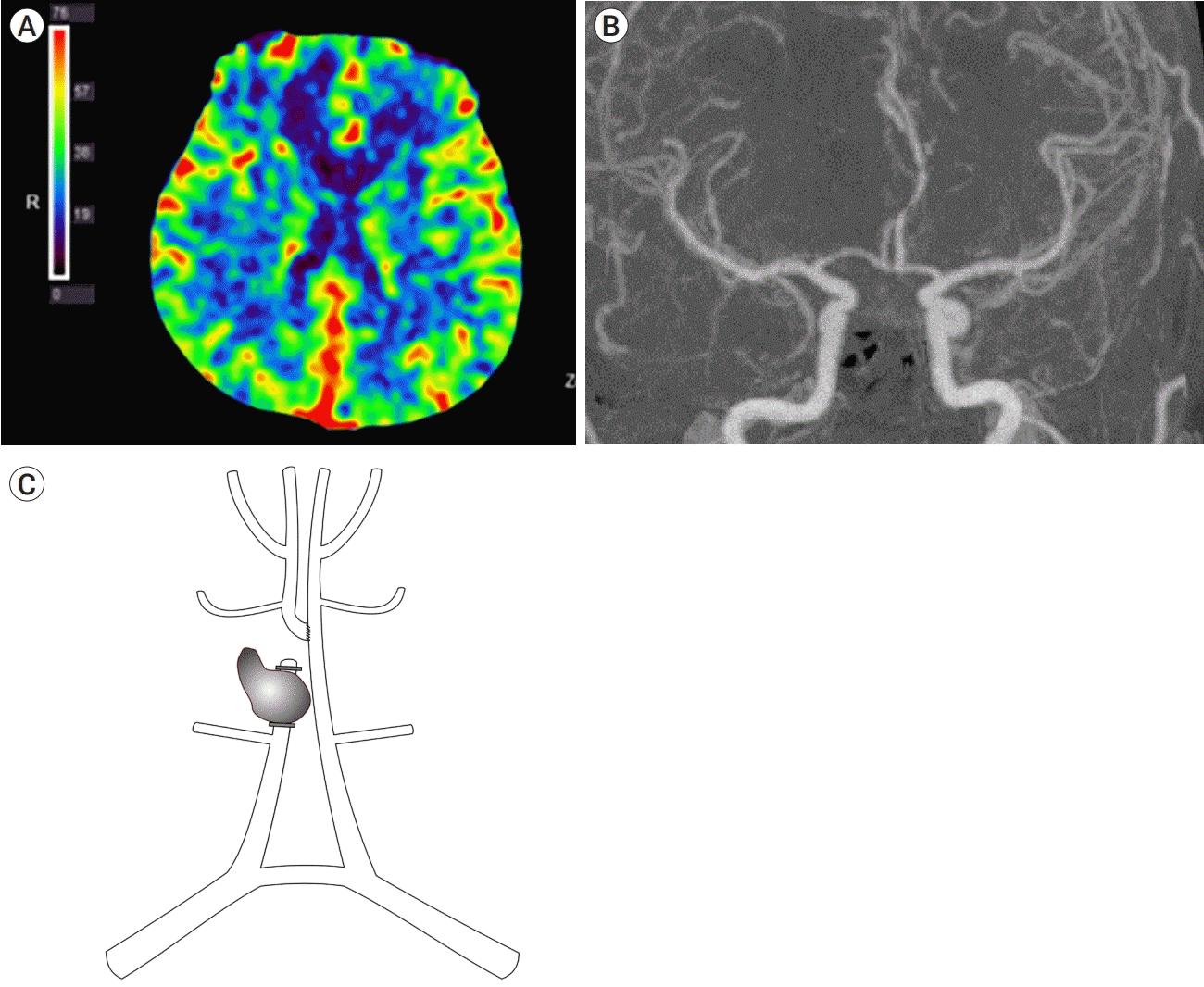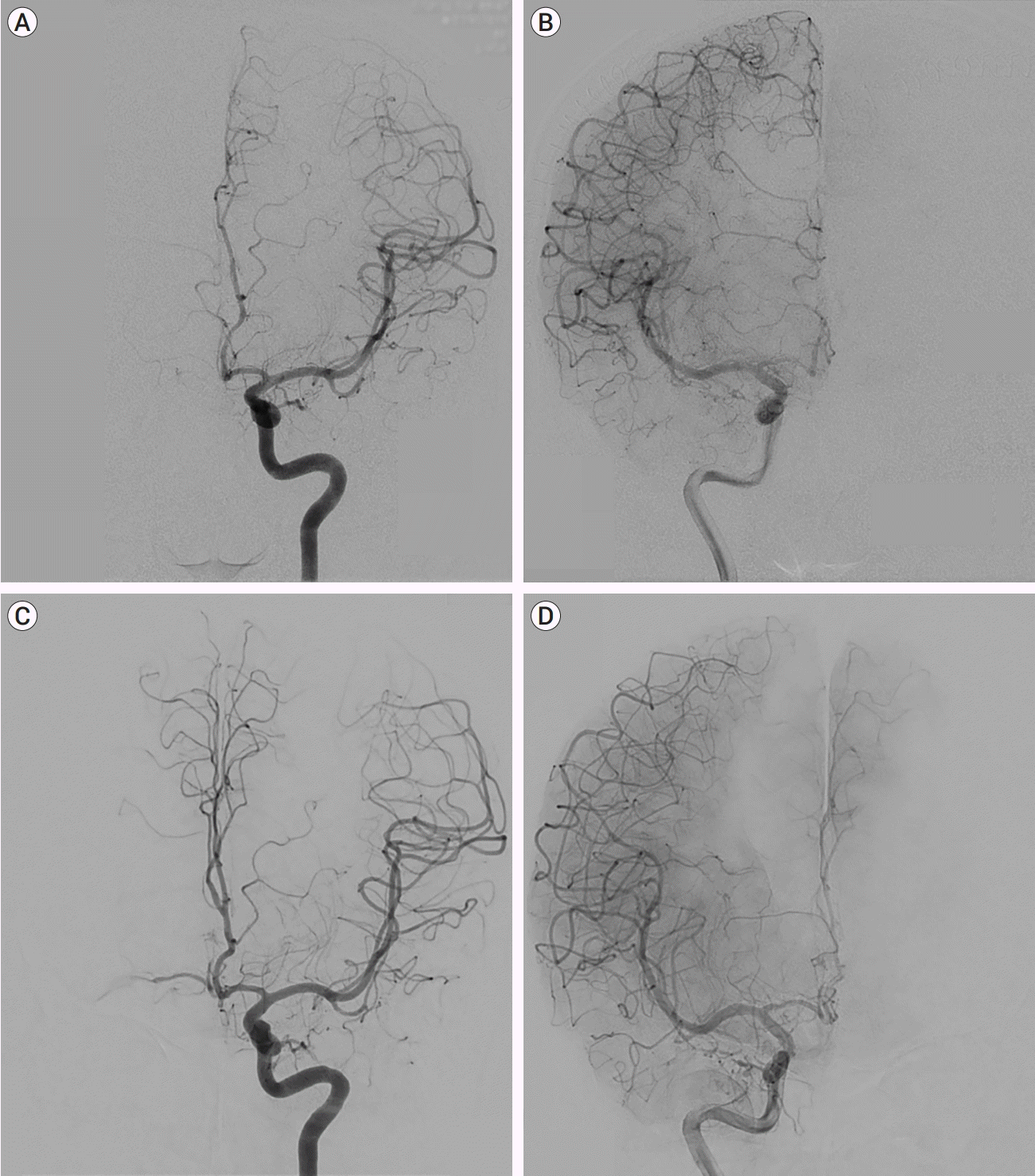Abstract
The treatment of complicated anterior cerebral artery aneurysms remains challenging. Here, the authors describe a case of ruptured complicated A3 aneurysm, which was treated with trapping and in-situ bypass. A 47-year-old man presented to the emergency department with severe headache and vomiting. Computed tomography illustrated acute intracerebral hemorrhage in the right frontal lobe. Digital subtraction angiography (DSA) confirmed a ruptured fusiform A3 aneurysm with lobulation and a daughter sac. Trapping of the ruptured fusiform A3 aneurysm and distal end-toside A4 anastomosis was performed. DSA on postoperative day 7 showed mild vasospasm to the afferent artery. However, 2 months later, DSA demonstrated that the antegrade flow through the anastomosis site had recovered. Thus, surgeons should be aware of the possibility of postsurgical vasospasm of anastomosed arteries, especially in cases of ruptured aneurysms.
Complicated anterior cerebral artery or anterior communicating artery aneurysms, which are difficult to treat with routine microsurgical clipping or embolization, can be treated with bypass surgery. The authors describe a case of a fusiform A3 aneurysm, in which trapping of the aneurysm and A4-A4 end-to-side anastomosis were performed, and the potential risk of vasospasm when in-situ bypass is performed on ruptured aneurysms.
A 47-year-old man presented to the Emergency Department with a severe bifrontal headache (numerical rating scale 5) and vomiting that started one day ago. The patient’s Glasgow Coma Scale score was 15. Pupillary light reflex was 3/3 and prompt. Initial computed tomography (CT) revealed an approximately 10 cc intracerebral hemorrhage in the right frontal lobe and the genu of the corpus callosum and intraventricular hemorrhage in all ventricles without definite hydrocephalus. Digital subtraction angiography (DSA) illustrated a fusiform A3 aneurysm with lobulation and a daughter sac that protruded into the rostrum of the corpus callosum (Fig. 1).
First, routine microsurgical clipping to directly clip the ruptured fusiform A3 aneurysm was planned, but surgery was also prepared to allow revascularization if direct surgical clipping failed. A bicoronal skin incision was made, followed by a large craniotomy to visualize A2 to A4 and allow space for a bypass if direct surgical clipping failed.
First, the surgeon (blanked for review) identified the portion of the anterior cerebral artery (ACA) distal to the ruptured aneurysm and dissected it along the corpus callosum and interhemispheric fissure to delineate the abnormally dilated distal ACA and the aneurysm itself. The deep nature of the aneurysm, the aneurysmal angle, and the distal ACA dilatation made direct tandem clipping difficult. Thus, trapping of the ruptured fusiform A3 aneurysm and distal end-to-side anastomosis between the ACAs was performed as an alternative solution. Because the middle internal frontal artery originated from the ACA just before the callosomarginal artery, side-to-side anastomosis was thought to be difficult; thus, the surgeon decided to perform the end-to-side anastomosis. The first clip was applied to the distal part of the A3 aneurysm, and to prevent intraoperative rupture of the aneurysm, the proximal part of the A3 aneurysm was occluded with a clip, thus trapping the aneurysm. A total of four temporary clips were applied to the proximal and distal bilateral ACAs. The deep portion of the anastomotic plane was sutured with 9-0 nylon in a continuous manner. The superficial portion was sutured in an interrupted manner. The total clamping time for both ACAs was 68 minutes (Fig. 2). After end-to-side anastomosis, using Doppler ultrasonography, the surgeon identified flow in the proximal contralateral ACA and both distal ACAs. Indocyanine green was injected and demonstrated flow to the bilateral ACAs and their branches, simultaneous cortical consumption filling, but the aneurysm could not be visualized.
Immediate postoperative perfusion angiographic CT illustrated symmetrically patent flow, and no perfusion delay was detected (Fig. 3). Because postoperative computed tomography angiogram (CTA) demonstrated intact flow to both the afferent and efferent arteries and the patient did not present with any neurological symptoms and signs, DSA was performed one week after surgery.
Postoperative one-week DSA showed mild vasospasm in the afferent ACA. Antegrade flow to the distal ACAs from the anastomosed parent ACA was faintly visible (Fig. 4A). Most of the distal ACA territory was retrogradely filled from middle cerebral artery cortical collaterals. The patient had no symptomatic vasospasm, and the vasospasm itself was not severe; thus, intra-arterial nimodipine was not injected.
On postoperative day #10, the patient underwent craniectomy and epidural scalp abscess removal due to a localized wound infection. The bone flap was removed, and a culture was performed. Klebsiella aerogenes was cultured from the bone flap, and ceftazidime was administered for 6 weeks. After 6 weeks of antibiotic administration, the patient did not demonstrate any signs of infection, and the wound site was clean.
Before performing cranioplasty (approximately 2 months after the bypass), DSA was performed to check the flow again, demonstrating recovery of the vasospasm and intact antegrade flow via the ACA anastomosis. The aneurysm did not uptake any contrast media (Fig. 4B). The previous filling of the middle cerebral artery collaterals to the ACA region had disappeared. After cranioplasty, the patient was discharged from the hospital without any definite neurological deficits and is now undergoing 6 months of routine outpatient follow-up.
Complicated ACA aneurysms remain challenging treatment entities for neurosurgeons. There are no definite treatment protocols to treat these aneurysms. Currently, many complicated cases of ACA aneurysms are treated with neurointerventional techniques. A flow-diverting stent, which have been used for unruptured aneurysms, could have been used as a possible treatment option, but because flow diverter has not been proven in ruptured cases, the flow-diverting stent was excluded from our consideration. Thus, for various reasons, neurointervention was not a reliable treatment option for our patient.
Revascularization techniques involving bypass surgery are typical treatment options for these aneurysms [1,5,6]. Bypass techniques can be divided into two large fields: extracranial-intracranial (EC-IC) and intracranial-intracranial (IC-IC) bypass. Although EC-IC bypass is the more commonly used bypass technique for complex aneurysms, IC-IC bypass can be used as a simpler, less time-consuming technique. In our case, proximal and distal occlusion of the ACA at the side of the aneurysm was performed with distal IC-IC bypass [4]. According to Sanai et al., the advantages of IC-IC bypass over EC-IC bypass are as follows: similar diameter of donor-recipient arteries, decreased bypass lengths, and the lack of need to harvest additional donor arteries, reducing surgical durations [7]. These advantages were also evident in our case. Usually, ACA aneurysms are far from the extracranial donor artery; thus, the use of the extracranial donor artery for EC-IC bypass is difficult. In this situation, EC-IC bypass with interposition grafts and ipsilateral-contralateral superficial temporal arteries (STAs) could be an option [2,8]. However, harvesting extracranial bypass sources is time-consuming and difficult in emergency settings.
Although IC-IC bypass has many advantages over EC-IC bypass in the treatment of complicated ACA aneurysms, in cases of rupture, surgeons who perform in situ bypass should always consider the risk of vasospasm in the donor artery, which might result in a reduction of perfusion to the distal cerebral area. Thus, for patients with poor-grade subarachnoid hemorrhage (SAH)(thick SAH, high modified Fischer grade), a history of cigarette smoking, hypertension, and left ventricular hypertrophy (LVH) on electrocardiography, surgeons should consider the risk of vasospasm if IC-IC bypass is performed [3]. Luckily, our patient had sufficient retrograde flow to the ACA territories, thereby avoiding the formation of any ischemic events.
A case of A3 fusiform aneurysm that could not be directly clipped was successfully treated with the in-situ bypass technique. The in-situ bypass technique, if performed correctly, is a lucrative and feasible technique for treating complex ACA aneurysms. However, before performing this technique, neurosurgeons should consider the potential risk of vasospasm of the parent artery.
ACKNOWLEDGMENTS
Portions of this work were presented as poster form in 39th Annual Meeting (Spring) of the Korean Neurosurgical Society, April 29, 2021.
REFERENCES
1. Abla AA, Lawton MT. Anterior cerebral artery bypass for complex aneurysms: an experience with intracranial-intracranial reconstruction and review of bypass options. J Neurosurg. 2014; Jun. 120(6):1364–77.
2. Horiuchi T, Ichinose S, Agata M, Ito K, Hongo K. STA-ACA bypass using the ipsilateral free STA graft as an interposition graft and A3-A3 anastomosis for treatment of bilateral ACA steno-occlusive ischemia. Acta Neurochir (Wien). 2018; Apr. 160(4):779–82.
3. Inagawa T, Yahara K, Ohbayashi N. Risk factors associated with cerebral vasospasm following aneurysmal subarachnoid hemorrhage. Neurol Med Chir (Tokyo). 2014; Jun. 54(6):465–73.
4. Lee SH, Ahn JS, Kwun BD, Park W, Park JC, Roh SW. Surgical flow alteration for the treatment of intracranial aneurysms that are unclippable, untrappable, and uncoilable. J Korean Neurosurg Soc. 2015; Dec. 58(6):518–27.
5. Lee SH, Chung Y, Ryu JW, Choi SK, Kwun BD. Surgical revascularization for the treatment of complex anterior cerebral artery aneurysms: experience and illustrative review. World Neurosurg. 2018; Mar. 111:e507–18.
6. Ota N, Tanikawa R, Miyama M, Matsumoto T, Miyazaki T, Matsukawa H, et al. Surgical strategy for complex anterior cerebral artery aneurysms: retrospective case series and literature review. World Neurosurg. 2016; Mar. 87:328–45.
7. Sanai N, Zador Z, Lawton MT. Bypass surgery for complex brain aneurysms: an assessment of intracranial-intracranial bypass. Neurosurgery. 2009; Oct. 65(4):670–83; discussion 683.
8. Spetzler RF, Roski RA, Rhodes RS, Modic MT. The “bonnet bypass”. Case report. J Neurosurg. 1980; Nov. 53(5):707–9.
Fig. 1.
(A) Computed tomography demonstrates intracerebral hemorrhage, intraventricular hemorrhage, and a small amount of subarachnoid hemorrhage. (B) and (C) Digital subtraction angiography (both anteroposterior views and a lateral view) shows a right A3 fusiform aneurysm. (D) Three-dimensional reconstruction illustrates the fusiform aneurysm and the distal portion of ACA with an ectatic change. ACA, anterior cerebral artery

Fig. 2.
Microscopic view. (A) Aneurysm revealed after arachnoid dissection via an interhemispheric approach (inlet: interactive three-dimensional angiography). (B) After trapping the aneurysm, end-to-side anastomosis was performed by using ipsilateral A4 as the donor artery (black arrow) and contralateral A4 (white arrow) as the recipient artery. (C) Anastomosis was performed in a continuous manner for the deep plane and an interrupted manner for the superficial plane. (D) Indocyanine green angiography shows patent flow to both ACAs and the disapperance of the aneurysm. ACA, anterior cerebral artery

Fig. 3.
(A) Immediate postoperative perfusion CT demonstrates symmetrical flow to the bilateral ACA region. (B) CT angiography illustrates that the bilateral ACAs can be visualized distal to the anastomosis site and that the aneurysm has disappeared. (C) Schematic illustration of the trapping and A4-A4 end-to-side in situ bypass techniques. CT, computed tomography, ACA, anterior cerebral artery

Fig. 4.
(A) and (B) Angiography one week after surgery. Faint flow is shown from the left-sided internal carotid artery (ICA) to the right-sided anterior cerebral artery (ACA) distal to the anastomosis site. A mild degree of vasospasm of the left A1 and A2 is visualized. Right ICA angiography demonstrates prominent leptomeningeal collaterals of the middle cerebral artery to the right anterior cerebral artery territories. (C) and (D) Angiography two months postoperatively. Left ICA angiography shows disappeared vasospasm and restored flow to the right ACA through the anastomosis site. Right ICA angiography illustrates the absence of collateral flow from the middle cerebral artery to the ACA territory.





 PDF
PDF Citation
Citation Print
Print



 XML Download
XML Download